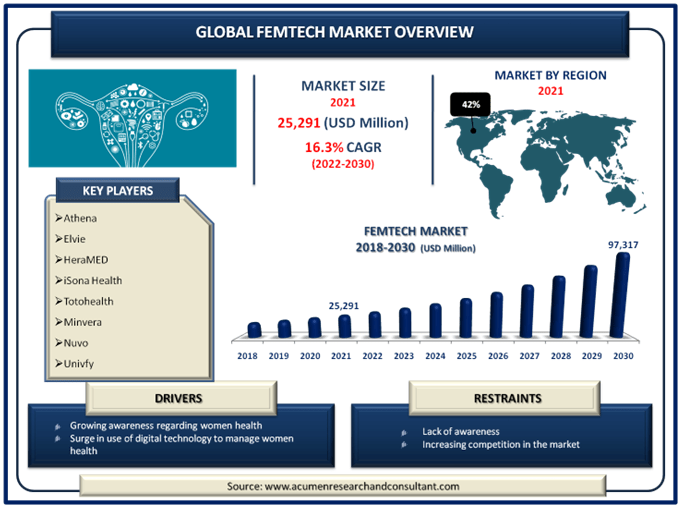Global Femtech Market size expected to reach USD 97,317 mn by 2030.

The global femtech market size is forecasted to grow at a CAGR of 16% over the forecast period and reach USD 97,317 million by 2030, according to Acumen Research & Consulting.
Femtech encompasses a variety of innovative technologies that serve women’s health concerns, such as menstruation or fertility issues, contraception or pelvic health, chronic conditions, sexual wellness, and other general health conditions (such as osteoporosis or cardiovascular disease).
Women’s health and wellness have been subject to misconceptions and inequities for many years. Women’s healthcare is lacking data due to the male-dominated nature of many clinical trials. To promote awareness and encourage women-specific firms, Ida Tin, the founder of the Clue period tracking app, created the name Femtech.
Because Femtech focuses primarily on women, it addresses the challenges that they face, from menstruation to menopause and pregnancy, through education and personalized services and products.
It is critical to address the gender gap in the healthcare industry in terms of education and the products available. In spite of the fact that femtech’s processes are still in their early stages, statistics show that public awareness, firm formation, and funding are all on the rise.
Global Femtech Market Overview

Femtech Market Report Coverage
| Market | Femtech Market |
|---|---|
| Market Size 2021 | USD 25,291 Mn |
| Market Forecast 2030 | USD 97,317 Mn |
| CAGR | Around 16% During 2022 – 2030 |
| Analysis Period | 2018 – 2030 |
| Base Year | 2021 |
| Forecast Data | 2022 – 2030 |
| Segments Covered | By Type, By End-Use, By Application, By Region |
| Regional Scope | North America, Europe, Asia Pacific, Latin America, and Middle East & Africa |
| Key Companies Profiled | Athena Feminine Technologies, Elvie, HeraMED, iSona Health, Totohealth, Minvera, Nuvo, Prelude, Sera Prognostics, Sustain Natural, and Univfy |
| Report Coverage | Market Trends, Drivers, Restraints, Competitive Analysis, Player Profiling, Regulation Analysis |
Women are prone to chronic and infectious diseases that require precise diagnosis and treatment, which fuels the growth of the industry.
In terms of process, the market can be divided into pelvic and uterine healthcare, pregnancy and nursing care, reproductive health, general healthcare & wellness, and others. Out of these, the reproductive health segment is anticipated to grow at the fastest rate all through the forecast period 2022 – 2030.
Over the forecast period 2022 – 2030, Asia-Pacific is expected to have the fastest growth in femtech. Women in the Asia-Pacific are experiencing a rise in chronic and infectious diseases. The growing number of start-ups in the region is creating awareness among women who are technologically backward and live in remote areas without access to emergency health services.
These female-centric startups are mainly concentrated in China and India, two of the most important markets in the region.
The Global Women’s Health Innovation Conference (GWHIC 2022) aims to bring together India’s start-up innovators and tech creators in the women’s health care industry along with other key stakeholders, and investors to help shape the conversation around women’s health innovation and the future of FemTech in India.